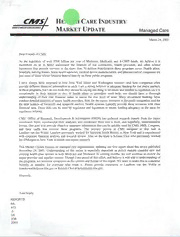
Wall Street's view of managed care : the managed care industry continues to benefit from an upswing in the underwriting cycle by pricing premiums ahead of projected medical costs PDF
Preview Wall Street's view of managed care : the managed care industry continues to benefit from an upswing in the underwriting cycle by pricing premiums ahead of projected medical costs
CMS, He. aCareIndustry CB/miStorMDKAKiMeOIOUOSBMaS MarketUpdate ManagedCare March24,2003 DearFriendsofCMS: Astheregulatorsofover$500billionperyearofMedicare,Medicaid,andS-CHIPfunds,webelieveitis incumbentonus to betterunderstand the finances ofourcontractors, health providers, and otherrelated businessesthatprovideservicestothemorethan70millionbeneficiariestheseprogramsserve.Healthplans, hospitals,nursinghomes,homehealthagencies,medicaldevicemanufacturers,andpharmaceuticalcompaniesare justsomeofthosewhosefinancesdependheavilyonthesepublicprograms. — IhavealwaysbeensurprisedathowlittleWallStreetandWashingtoninteract andhowcompaniesoften providedifferentfinancialinformationtoeach.Iamastrongbelieverinadequatefundingforourmajorpartners intheseprograms,butIdonotthinktheyshouldbesayingonethingtoinvestorsandanothertoregulators(asitis occasionally in their interestto do). Ifhealth plans orproviders need help, we should have a thorough understandingoftheirrealfinancialstatustoassessthetruelevelofneed.Manyinvestmentbankingfirms conductdetailedanalysesofmajorhealthproviders,bothfortheequityinvestorsinfor-profitcompanies,andfor thedebtholdersoffor-profitandnonprofitentities.Healthsystemstypicallyprovidetheseinvestorswithclear financialdata.Thesedatacanbeusedbyregulatorsandlegislatorstoassessfundingadequacyortheneedfor regulatoryreforms. CMS'OfficeofResearch,Development&Information(ORDI)hasgatheredresearchreportsfromthemajor investmentfirms,summarizedtheiranalyses,andcondensedthemintoashort,andhopefully,understandable format.OurgoalistoprovideobjectivesummaryinformationthatcanbequicklyusedbyCMS,HHS,Congress, and their staffs that oversee these programs. The primary person at CMS assigned to this task is LambertvanderWalde.LambertpreviouslyworkedforSalomonSmithBarneyinNewYorkandisexperienced withcorporatefinancialanalysisandresearchreview.AlsoontheteamisKristenChoiwhopreviouslyworked forJPMorganinNewYorkinhealthcareequityresearch. ThisMarketUpdatefocusesonmanagedcareorganizations,updatingourfirstreportaboutthissectorpublished November28,2001.Understandingofthissectorisespeciallyimportantaspolicymakersconsidernewand existinghealthplanoptionsinbothMedicareandMedicaid.Incomingmonths,wewillcontinuetoreviewthe mthaejoprropgrroavmisd,erwaenwdeslucppolmieercsoemcmtoerns.tsThoonutghhecIoanmtenptroaunddoffortmhiasteofffotrhti,sarnedporbte.liWeveewitawnitlltoadmdakteoutnhidserasstcaonndisnugmeorf friendly as possible for everyone who reads it. Please provide comments to Lambert van derWalde at [email protected]@cms.hhs.gov. Sincerely, TomScully REPORTS RA 413 .5 U5 V36 2003 HealthCareIndustry canm»*Maicmtmi)icuDSBmas MarketUpdate ManagedCare March24,2003 TomScully Administrator OfficeofResearch,Development &Information: LambertvanderWalde [email protected] [email protected] Wall Street's View of Managed Care JenniferHiggins Themanagedcareindustrycontinuestobenefitfromanupswingin [email protected] theunderwritingcyclebypricingpremiumsaheadofprojected medicalcosts. Profitmarginsforthepubliclytradedmanagedcare companiesareexpandingbutremaininthelowsingle digits,fromanaverage1.8%in1999to4.4%in2002. Analystsexpect2003tomarkthethirdconsecutive yearofdouble-digitpremiumincreases.Employers continuetoshiftmorecostsontoemployees. Thecommercialmarkethasmovedtowardsmore openandflexibleplans,with70%ofenrolleesinPPO orPOSplanscomparedto26%inHMOsin2002. Commercialmanagedcareorganizationshave reducedMedicaremanagedcare(Medicare+Choice) revenueexposureoverthelastseveralyears. Medicaidmanagedcareplanscovered58%of beneficiariesin2002.AnalystsexpectMedicaidHMO enrollmenttogrowbuthaveconcernsaboutthe potentialimpactofstatedeficits. 81 Contents ExecutiveSummary 3 WallStreet'sView 4 IndustryOverview 8 History 8 IndustryLandscape 1 IndustryPerformance 15 Profit 15 Revenue 1 MedicalLossRatio 21 AdministrativeLossRatio 26 ReserveAnalysis 27 AccesstoCapital 31 EquityandDebtIssuance 31 UsesofCapital 32 StockMarketPerformance 33 MergerandAcquisitionActivity 35 Payors 36 Private 36 Public 38 Medicare 39 Medicaid 42 Summary 44 cms. ManagedCare-March24,2003 ExecutiveSummary Themanagedcareindustrycontinuestobenefitfromanupswingintheunderwriting cProonftiitnmuaertgoingsrowfor cycle.Profitmarginsareexpandingbutremaininthelowsingledigits.Forthepublicly bothfor-profitand tradedcompanies,profitmarginsincreasedfrom1.8%in1999to4.4%in2002.Similar nonprofitmanaged marginimprovementhasbeenobservedamongtheBlueCrossBlueShieldplans,the carecompanies. publiclytradedMedicaidHMOs,andKaiserPermanente,thelargestnonprofitHMOin thecountry. Premiumsforcommercialhealthplanshaverisenatdouble-digitratesforthepasttwo years(up11.0%in2001and12.7%in2002).Someinvestorsareconcernedandbelieve thatemployerresistancewillslowtherateofpremiumincreases.Thepubliclytraded managedcarecompanies,however,projectthataveragepremiumswillrise12%to13% Medicalcostsare whilemedicalcostswillrise11%to12%onaveragein2003.Mostofthesecompanies expectedtorise expecttomaintainorexpandprofitmarginlevels.Analystsalsohaveobservedan 11%-12%in2003. increaseinbenefitbuydownsorcostshifting.(Benefitbuydownsarebenefitreductionsor increasedemployeecost-sharingdesigns.)Whilebuydownsreduceoverallrevenuesfor themanagedcarecompany,thiscostshiftingcanalsolowerbothutilizationandoverall costsofhealthcareservicesbyincreasingpatients'out-of-pocketcosts. Thecommercialmarkethasmovedtowardsmoreopenandflexibleplandesigns,ashift thatanalystsexpecttocontinue.In2002,overtwo-thirdsofcommercialenrolleeswere enrolledinPPOorPOSplans,comparedtoonlyone-quarterinHMOs.Turningaway Overtwo-thirdsof fromthedirectutilizationcontrolsofHMOs,PPOsandotherhybridplansincorporate AcenomrmeomrleilrcecdainiasnllaPyrPeiOnsourred octoh-epraymse.cThhaeninsummsbetorcoofntermoplluotyielrizsattihoantainncdocropsotrsa,tesudcihseaassetimeraendapgheamremnatcyinatondheparlotvhipdlearn POSplans. designsroseto50%in2003from44%in2002,accordingtoGoldmanSachs.Analysts alsoexpectthecommercialmarkettocontinueshiftingtowardself-fundedplans,which arenotsubjecttostate-mandatedbenefitsunderERISAandcanbettercontrolcosts. eMnarnoalglmeedntcairse MHeeadlitcharcear+eChcoositcsei(nMm+aCn)yppaarytmsenotfst.heAcsoaunrtersuyltc,onmtainnuyeMto+eCxcpeleadnsahvaaivleabrleeducedbenefit decliningin packagesorexitedfromcertainmarketsaltogether.Inlate2001,WallStreetanalysts Medicare... typicallywerelessoptimisticaboutcompanieswithhighM+Cparticipationbutnowseem lessconcernedasM+Chasbecomeadecliningrevenuesourceformostofthesector. Medicaidmanagedcareenrollmenthasgrownrapidly,increasingfrom40%ofMedicaid beneficiariesin1996to58%in2002.Medicaidmanagedcareincludescomprehensive ...whilegrowing benefitplanssuchasprimarycarecasemanagement,prepaidhealthplans,andHMOs,as rapidlyinMedicaid. wellasmorelimitedplanssuchasmentalhealthorpartialhospitalizationprograms. AnalystsbelievethatMedicaidistheonlymarketwhereHMOenrollmentwillgrow. TheSalomonSmithBarneymanagedcareindexhasdeclined1.1%year-to-date(asof 3/13/03)comparedtoadeclineof5.4%fortheS&P500.Inrecentquarters,sector performancehassufferedpartiallyduetoinvestorconcernaboutreservesandrelated earningsquality.Despitetheconfusion,however,mostanalystsareconfidentinthe qualityofreportedearningsbythemanagedcaresector.Strongcashflowhasgenerated excesscapital,whichistypicallyusedtoretiredebt,repurchasestock,andinvestin technology. ManagedCare-March24,2003 -3- WallStreet'sView Themanagedcaresectorcontinuestobenefitfromanupswingintheunderwriting cycle.Managedcareisaninsurancebusinesssubjecttothenaturalswingsofthe underwritingcycle.Companiesmustpricetheirinsuranceproductswellinadvanceof whenmedicalservicesarerenderedinthefollowingyear.Managedcareprofitabilitythus reliesonaccuratepredictionsofmedicalcosttrends.Whenpremiumgrowthexceeds medicalcostgrowth,theunderwritingcycleisontheupswing;theoppositeistrueina downswing.Thosecompaniesthathavebetteractuarialabilitytoforecastmedical expensetrendscanreducethevolatilityoftheunderwritingcycle. CharlesBooradyofSalomonSmithBarneywrites,"Asbackgroundontheprofitcycle, WpraolflitStgrreoewttehxipnec2t00s3. minadrugsitnryexmpaarngsiinosn.d"ecBloionerdadfyrowmrit1e9s9,4-"1F9o9r92,0a03n,dwweeeaxrepencotwprienmtiheumthaicrdceyleearratoifoncyacnlidcal medicalcostabatementtosetabackdropforrecordmargin-drivenprofitgrowth." Whilethenear-termoutlookispositive,someinvestorsdebatewhetherpremium increaseshavepeaked.Investorsarecautiousastothesustainabilityofthecurrent positivetrend.JohnRexofBearSternswrites,"Witheachpassingyear,investors increasinglyquestionthesustainabilityofmarginsandfearthepotentialimpactofthe inevitabledeceleratingpremiumincreaseenvironment." Someinvestorshavebeenconcernedthatpremiumincreaseshavepeaked.Average increasesinhealthplanpremiumshaveacceleratedinrecentyears:up8.3%in2000, 11.0%in2001,and12.7%in2002,accordingtoKaiser. Premiumincreasesareexpected asmedicalcostsrise,butinvestorsareconcernedthattherateofpremiumincreaseswill slowasemployersarepressuredtoreducecostsincludingbenefitexpenses.CreditSuisse FirstBoston(CSFB)believes,"Employerssimplycan'tabsorbdoubledigitrateincreases everyyear...."Booradycitestheuncertainlybehindachievingpremiumincreasesina weakeconomytobetheindustry'sbiggestrisktoday.RobertaGoodmanofMerrillLynch writes,"Wehaveheard{adnauseum)concernsthat'thepricingcycleispeaking'... [although]managedcarestockperformancehasminimalcorrelationwithpricingtrends." Mostanalysts,however,emphasizethattheindustrycontinuestoshowstrong pricingdisciplinebypricinginsurancepremiumsaheadofprojectedmedicalcost trends.Rexdiscouragesoveremphasisonpricingdeceleration,andwrites,"[I]tisthe marginor'spread'storyuponwhichweshouldfocus,andweseeevidencethatthe Analystsexpect majorityofhealthplanscontinuetopriceat,orslightlyabove,existingcosttrendlevels." healthplanstoprice For2003,mostmanagedcarecompaniesexpectstrongaveragepremiumincreasesof pcorsetmtiruemnsdsa.headof s1o2m%etcoo1nc3e%r,nshiogvheerrathpaenaakvienrgapgreiceixnpgeccytcelde.meSdailcoamlocnosStmtirtehndBsaorfne1y1a%natloys1i2s%s,haolwlsaytihnagt premiumandcosttrendshavebeencloselymatchedoverthepastseveralyears,and estimatesthatpremiumswillrisefasterthancoststhrough2005. ManagedCare-March24,2003 -4- Figure1:PremiumversusCostIncreases 1988 1989 1990 1991 1992 1993 1994 1995 1996 1997 1998 1999 20002001E|20026|2003E2004E2005E2006E Source:SalomonSmithBarneyResearchestimatesbasedondatafromCMS,MillimanUSA,AAHP,andK.PMG.AsofFebruary27,2003. Analystsinterpretthisstrongpricingdisciplineasasignthattheindustryhaslearnedfrom previousmistakes.Thelastseveredown-cycleofthemanagedcareindustrywasfrom 1994to1999.Duringthistime,industrymarginserodedduetoaggressiveprice competitiontoattractenrollment.Manyoftheirrationalpricersofthemid-1990sno longerexist.JoshuaRaskinofLehmanBrotherspointsout:"Despiteallthespeculationas towhatcoulddriveyieldslower,wehaveyettohearanyonesuggestthatmanagedcare companiesareengaginginapricewarorlookingtogain[market]share." Therehasbeenameaningfulincreaseinbenefitbuydownsin2003,whichtendsto increaseinvestorconcernaboutactuarialaccuracy.Withrisinghealthcarecostsanda Benefitbuydowns, weakeconomy,employersareseekingtomitigatepremiumincreasesbyshiftingcosts whichshifthealthcare ontoemployeesthroughbenefitbuydowns.Buydownsincludehigherpremiumcost- tceooxspetemscptlfeordyoemteoesim,npcalrroeeyaesres psrheasrcinrgi,pthiiognhderrugcso.-pBayymiennctresasainndg/otrhecoe-mipnlsouryaenec'es,fainndanicinaclresatsaekdeuisnetoheftcioesrteodfchoe-aplatyhscfaorre, in2003. buydownscanalsoreducetheriseofpremiumsbydiscouragingunnecessaryutilizationof healthcareservices. Byreducingtheriseofpremiums,benefitbuydownsalsoslowoverallrevenuegrowthfor themanagedcarecompany.ScottFidelofJPMorganexpectsbuydownstoincrease3.0to 4.0percentagepointsin2003,comparedto1.0to2.0percentagepointsin2002.Raskin writes,"Whentheprevalenceofbenefitbuy-downsescalates,itbecomesanunderwriter's gameandthecompanieswhohavegooddatacollectionandpricingdisciplinearebetter positionedtogrowprofitablyversustheircompetitors." c/vrs. ManagedCare-March24,2003 -5- Mostmanagedcarecompaniesforecastanincreasedmedicalcosttrendof11%to 12%in2003.Medicalcosts,orbenefitexpenses,aretypicallycomposedofinpatient hospitalservices,outpatienthospitalservices,physicianservices,andprescriptiondrug spending.Ifgrowthinmedicalcostsdeceleratesfasterthanexpected,thiscouldcontribute tohigherprofitmargins. Analystsdebatewhetherthemedicalcosttrendisabating.Goodmanpredicts,"Weexpect meevdeincdaelcecloesrtattrieonndsoftothreisrea.t.e.oafltihnocruegahset.h"ereCaSrFeBfabcetloiresvpeso,in"tWihngilteopaostelnotwiadlomwondienra[tgiroonwtohr of]pharmaceuticalcostswillbenefitmanagedcare,itcomesatatimewhenprovider costs,whichaccountfor40-45%oftotalmedicalexpenses,arerisingatthefastestratein adecade,andwebelievetheoverallcosttrendwillremainlikelyunchanged."Despitethe speculation,mostmanagedcarecompanieshavecontinuedtoincorporateanincreased costtrendofabout11to12%whenpricinghealthplans.Fidelbelievesthatmanagedcare companies"remainconservativeanddisciplinedintheirapproachtopricing." Analystsarecallingforincreasedaccountingdisclosureregardingreservelevels, whichhaveamajorimpactonreportedearningsofmanagedcarecompanies. Investorsunderstandthatmanagedcarecompanieshavecertaindiscretionwhenreporting earnings.Thisflexibilitystemsfromthefactthatreportedmedicalexpensesinagiven quarterincludeestimatesofclaimsthathavebeenincurredbutnotreported(IBNR). Companiesmustestablishreservesinordertorecognizeclaimstobepaidinthefuture, andmoststatessetreserverequirementsforplansoperatinginthatstate.Fewcompanies breakoutIBNRclaims,andthusitbecomesdifficultforinvestorstoanalyzereserve adequacyaswellastheimpactofreservesonreportedearnings.1 Concernsoverreserveshavetroubledmanagedcarestocksrecently,althoughmany companiesreportedearningsaboveexpectations.CSFBbelieves,"[If]welearned anythinglastyear,itmightbethathitting,orevenbeatingthenumbersisnotalways enough....Themarket'sresponsetothepastfewquartersarguesforalotmoredetailon reserves,asinvestorsarepayingcloserattentiontothequalityofearnings,anddemanding Investors'attentionon greaterdisclosure."Fourthquarterearningsreportswerefilledwithadditionalreserve troesaedrdvietiloenvaellsinhdausstlreyd disclosures.AlthoughWilliamMcKeeverofUBSWarburgnotes,"Investorshavebeen disclosure. confusedbytheadditional[reserve]information,"hesummarizes,"[T]hecompanies remainconservativeintheirreservesetting,andwebelievesomeinvestorshave overstatedtherisksonthisissue." Manymanagedcarecompanieshaveshiftedtheirbusinessmixtowardsself-funded productsorothernon-risklinesofbusiness.Thelargestmanagedcarecompanieshave beenactivelypursuingfee-basedandspecialtyservicesbusinesses,"whichoffermore predictableanddependablerevenueandearningsstreams"thanrisk-basedbusiness, accordingtoFidel.Largeemployersalsohaveshownpreferenceforself-fundedplans, underwhichtheemployeritselfassumestheriskoflossforitsmembers.Employers enjoymorebenefitdesigncontrol,whichcanresultinbetterbenefitcosttrends,overself- fundedversusriskproducts.MatthewBorschofGoldmanSachsbelievesthatthisshiftis akeyreasonforfuturemoderationoftheindustry'sprofitcycles,sincetheindustryhas "lessearningsexposuretounanticipatedchangesinmedicalcosttrendasagreater proportionofearningsaredrivenbyfee-based(self-insured)andspecialtyproducts." 1Forfurtherdiscussionofreserveanalysis,seepages27-30. CA0S, ManagedCare-March24,2003 -6- Analystsnotethatconsolidationinhealthplanscontinues,especiallyamongBlue CrossBlueShieldplans.Managedcarecompaniesaredriventoconsolidatethrough increasingeconomiesofscale,investmentintechnology,risingcostsofmedicalclaim insurance,andincreasingstatestatutorycapitalrequirements.Consolidatedhealthplans createlargermembershipblocks,increasingbargainingleveragewithprovidersand Analystsexpect leveragingadministrativecosts."Competitivecapacityhasbeensignificantlyreducedasa industryconsolidation resultofthelastdowncycle,whichledtothefailureofmanyprovider-sponsoredhealth plansandtheexitofnationalfirmsfromtheirweakermarkets,"notesBorsch.The numberofHMOshasdeclinedfrom643in1999toonly490in2002. Fidelwrites,"WeexpecttoseeindustryconsolidationinboththeBlue[CrossBlue Shield]domainandwiththecommercialinsurers."FidelpredictsthatthenumberofBlue planswilldeclinefrom42currentlytoaround25or30overthenextfiveyears,drivenby theconversionofseveralBluestofor-profitstatusandtheopportunityofmergedBlue planstoleveragestrongmarketsharepositionsintheirrespectivemarkets. Nonprofitmanagedcareplanshaveconvertedorareconvertingtofor-profitstatus. Healthinsuranceenrollmenthashistoricallybeenweightedtowardnonprofitcompanies. However,severalBlueplanshaveconvertedtofor-profitstatus,changingthedistribution ofinsuredlivestothefor-profitsector.Analystsgenerallybelievethatthistrendbrings greaterrationalitytothemanagedcareindustry.Booradywrites,"Inourview,asmore nonprofitsandmutualcompaniesconverttofor-profitstatus,itwillinstillmoreefficiency andpricingdisciplineintheindustryandelongatethepositiveunderwritingcycle."There arefourpubliclytraded,for-profitBluemanagedcarecompanies(Anthem,Cobalt, WellPoint,andWellChoice),whichcover26millionlivesin14states,or29%ofall coveredBluelives.Severalmoreareattemptingtoconverttofor-profitstatusduetoan acquisitionoronastand-alonebasispendingapprovalfromstatelegislaturesor regulatoryauthorities.2 2OnMarch5,2003,theMarylandinsurancecommissionerdeniedCareFirst'sapplicationforconversionandsaleto WellPoint.(WellPointfirstannouncedtheproposedtransactiononNovember20,2001.)TheMarylandInsurance Administrationfoundthattheproposedtransactionwasnotinthepublicinterest,basedonseveraldisqualifying factorsandseveralmandatoryconsiderationsrelatingtotheintegrityoftheprocessthatwerenotsatisfied.This decisionbecomeseffective90daysfollowingtheannouncement,isthensubjecttovotebytheMarylandlegislature, andmaybefollowedbyanappealsperiod. _CA£S> ManagedCare-March24,2003 -7- * IndustryOverview Managedcareisageneraltermforahealthcaresystemthatmanageshealthcaredelivery inordertoimprovequalityandcontrolcosts.Amanagedcareorganization(MCO)isan entitythatfinancesandmanageshealthcaredeliverythroughnetworksofdoctors, hospitals,andspecialtyproviders. Typesofmanagedcareplansincludehealthmaintenanceorganization(HMO),preferred pflreoxviibdlee.rHorMgaOnimzaetmiboenr(sPPtOy)p,icaalnldypcohionto-soef-asperrviimcaery(PcOaSr)e.pThyhseicHiManOfrsotmruactnueretwisortkheolfeast providerswithwhichtheplanhasnegotiatedcontractedrates.Theprimarycarephysician Thespectrumof actsasagatekeepertoanyspecialtyphysiciansorservices.HMOpremiumsaretherefore fmmroaornmeagsftelredixcitcbalHerMePOPrsuOnsts.o uresfuearlrlayll(eolwiemrintahtainntghtohseegfaotreokteheeprertyrpoelse)ofanpdlaanls.loPwPmOes,mboenrtshetootsheleerchtapnhdy,siaclilaonwssferlfo-m eitherabroaderpreferredprovidernetworkor,forahigherout-of-pocketcost,outof networkaltogether.PPObeneficiariestypicallypayfortheadditionalflexibilitywitha highermonthlypremiumthantheywouldinanHMO.Apoint-of-service(POS)plan blendstheHMOandPPOmodels,typicallyrequiringpatientstoselectanin-network primarycarephysician,butallowingself-referralandout-of-networkphysicianaccess withhigherdeductibleandco-insurancecoststhanreferredin-networkoptions. Allofthesemanagedcareproducts,andtheirhybrids,seektoreininthehighercosts associatedwithatraditionalfee-for-service(indemnity)modelofhealthcareinsurance, butareoftenatrade-offbetweencostandflexibility.Traditionalfee-for-serviceplans providethesamereimbursementregardlessofprovider.Premiumsforfee-for-service plansaregenerallymoreexpensivethanthoseformanagedcareplans. Figure2:TypesofHealthPlanDesignsandEnrollment 2002 Enrollment* Product Access Percentage HMO Networkonly 26% POS Networkorout-of-network 18% PPO Networkorout-of-network 52% Indemnity Open 5% *Includesprivate,employer-basedmarket.Figuresmaynotaddduetorounding. Source:CreditSuisseFirstBostonandKaiser/HRETSurveyofEmployer-SponsoredHealthBenefits:2002. History HMOstracebacktothe1930s,whenselectgroupsofpatientsorcommunities,suchas lumberworkers,begantocooperatewithcertainproviderstoestablishpre-paidratesfor healthcareservices.TheseearlyHMOswerenon-profitplans,aswerethetraditional indemnityinsurerssuchasBlueCrossandBlueShield.Thefor-profithealthcareindustry hasitsrootsinthelate1960swhengovernmentspending,astrongeconomy,andpricing flexibilityspurredgrowth.Inthe1970s,demandforhealthcareservicescontinuedto increase,encouragedbyincreasedhospitalcapacityandthepurchaseofhigh-tech equipment. Duringthe1980s,asdemandforhealthcareservicescontinuedtoincrease,sodidcosts. Asexplainedinmoredetailbelow,manyemployersattemptedtocontrolcostsby applyingtheHMOmodelonabroadscaletolargegroupsofemployees.Theresulting decreaseinpatientchoicecauseda"backlash"againstrestrictivemanagedcareplansin ManagedCare-March24,2003 -8- thecommercialmarketinthe1990s.Althoughcommercialenrollmentrecentlyhas favoredlessrestrictivemanagedcareplans,employerstodayoftenofferarangeofhealth plansatdifferentcosts,allowingtheindividualtochoosewhattypeofhealthplanbest suitshisorherneeds.ManytraditionalHMOplanscontinuetoservetheircommunities well,withnotableexamplesincludingKaiserPermanenteandGroupHealthCooperative. TheRiseofHMOsinthe1980s Duringthe1980s,employers'growingconcernoverrisinghealthcareexpendituresfueled demandformanagedcareplans.Privatehealthinsurancefundingoftotalhealth expendituresroseduetobenefitexpansionandenrollmentincreases.Meanwhile,private healthinsurancewasalsoattemptingtoreduceunnecessaryhospitaluse.Inaddition,the TaxEquityandFiscalResponsibilityActof1982(TEFRA)limitedhospitalcostsandset thestagefortheprospectivepaymentsystem(PPS)enactedthefollowingyearthat establishednewlimitsonMedicarepaymentsforinpatienthospitalcosts.Duringtheearly yearsofPPS,Medicarepaymentswereinitiallyhigherthanhospitalcosts.WhenPPS paymentswereadjusteddownwardtobetterreflectactualcosts,thisalsocausedprivate sectorspendingasapercentoftotalexpenditurestorise.In1975,privateinsurance accountedfor23%oftotalnationalhealthexpendituresof$130billion.Tenyearslater, privateinsuranceaccountedfor30%oftotalnationalexpendituresof$427billion. Figure3:NationalHealthExpenditureFundingShiftstoPublicandPrivateInsurance Payors Anastiaonpaelrcheenatltohf mPublicTotal expenditures,private PrivateOther oihunatss-uorrfia-snepcnoectksoept3e5nd%iwnhgile PPrriivvaatteeOIunts-uorfa-nPcoecket spendinghasdeclined to14%. 1965 1975 1985 1995 2001 Source:CMS,OfficeoftheActuary.NationalHealthStatisticsGroup.Figuresmaynotaddduetorounding. Privateinsurerspassedtheserisingcostsalongtothemajorpurchasersofhealth insurance,theemployers.EmployersviewedtheHMOmodelasasolutiontotheproblem ofrisinghealthcarecosts.AsHMOsgainedtractioninthe1980s,manyHMOsconverted tofor-profitstatusandtraditionalfee-for-serviceinsurersboughtorlaunchedtheirown HMOplans.Intheearly1990s,healthcareprovidersincludinghospitalsandphysician groupsalsobegansponsoringtheirownHMOs,offeringdiscountpremiumstogain enrollmentandthereforeservicevolumeattheirfacilities.Thiseventuallycontributedtoa pricingwarthatcompressedindustryprofitmarginsduringtheindustry'slastdownswing inthemid-1990s.Manyoftheseprovider-sponsoredplansnolongerexist. _CA£S> ManagedCare-March24,2003 -9- '
